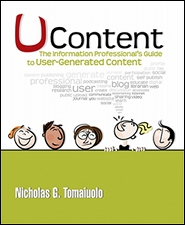UContent by Nicholas Toaiuolo
About the book
Author: Tomaiuolos, Nicholas G.
Title: UContent: The information professional’s guide to user-generated content.
Publication: Medford, N.J.: Information Today, 2012. 340p. ISBN 9781573874250
About the book
User-education librarian and information-literacy instructor Nicholas Tomaiuolo presents an overview of the major “Web 2.0” resources and how librarians might and have used them.
Because of the fungible nature of his material, he provides a companion website which he commits to updating with resources as they move or become available. The website, which links to the resources, sites and examples he discusses in the book, is organised in the same way as the table of contents. It both simplifies access for readers and updates them on changes that inevitably occurred during the publication lag and subsequently.
He sets the stage by charting the evolution of user-generated content (UContent), including blogs, wikis, videos and social media. He quickly looks at the early internet, including academic collaboration, BBS systems and newsgroups, through the rise of blogs and wikis, to user-review sites and the Creative Commons and GNU free licensing systems.
Next, he touches on social bookmarking sites and the issues associated with free tagging or “folksonomy”, and moves on to mention “Web 2.0” sites such as flickr, and describes the criteria for a “social networking” site. His introduction continues with the pros and cons of user-generated content, and the (American) legal ramifications of hosting user-generated content on an institutional site.
The second chapter follows the author’s attempts to upload an item from his library’s collection to Project Gutenberg. The author describes all the steps that he took, at the same time introducing the reader to the process of collaborative publishing, standards and precise requirements for participation. Eight days of one-on-one work with an experienced editor allowed the author to contribute a book to the project, and to understand very clearly that “the user is not always in control of the content” (p. 32) when working collaboratively. He ends the chapter with an interview with Micheal Hart, open-source pioneer and founder of Project Gutenberg, who died in September of 2011.
The next chapter discusses blogs, for most people perhaps the most familiar type of user-generated content and the one with the lowest barrier to entry. Tomaiuolo uses blogs to illustrate the “social” element of “social software” or “social networking”, and to explain basic concepts such as tags, categories and networking concepts like blogrolls and trackbacks. A big part of this chapter is dedicated to librarians and to the personal and professional benefits of blogging for librarians in particular, how to find library blogs of interest, and cautions that “blogging is not a private act” so professionalism is important. This chapter concludes with an interview with Walt Crawford, blogger and editor of the e-journal Cites & insights.
The fourth chapter looks at wikis, focusing first on the Library Success wiki and interviewing its founder, Meredith Farkas. Then he looks at Wikipedia, and examines libraries successfully using it, many to promote their digital Collections. He interviews Dreanna Belden on her university’s Wikipedia initiative before describing his own forays into collaborative encyclopedia editing. He provides a brief tutorial on How to edit, and interiews Phoebe Ayers, wikipedian and Co-author of How Wikipedia works, the premier printed resource on the encyclopedia.
Here is what the other chapters discuss:
- Chapter 5 Podcasts, slides, screencasts and video
- Chapter 6 Facebook
- Chapter 7 Online reviews of products and services
- Chapter 8 Self-publishing
- Chapter 9 Citizen journalism
- Chapter 10 Tagging, folksonomies and social bookmarking
- Chapter 11 Custom search engines
- Chapter 12 Cybercartography
- Chapter 13 Yahoo! Pipes
- Chapter 14 Flickr
Recommended?
It’s a useful book if you are interested in the tools he discusses. It’s sort of a journal of his trials and errors, but shows the reader that this kind of experimentation is not a dangerous and frightening thing.
